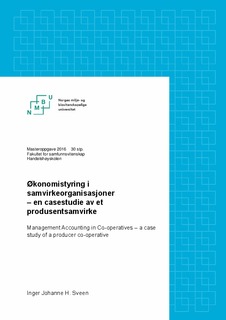| dc.contributor.advisor | Pettersen, Inger Johanne | |
| dc.contributor.advisor | Gladheim, Arve | |
| dc.contributor.author | Sveen, Inger Johanne Helth | |
| dc.date.accessioned | 2016-08-23T09:25:44Z | |
| dc.date.available | 2016-08-23T09:25:44Z | |
| dc.date.issued | 2016-08-23 | |
| dc.identifier.uri | http://hdl.handle.net/11250/2400993 | |
| dc.description.abstract | Temaet for denne oppgaven er bruken av økonomistyring i en samvirkekontekst, nærmere
bestemt har studien sett på hvordan ledelsen i samvirkebedrifter bruker styringsverktøy for å
nå strategiske mål.
I Norge er samvirkeformen særlig mye brukt i organisasjoner knyttet til landbruket, og blant
Norges sterkeste merkevarer finner vi samvirkeorganisasjoner som Tine, Nortura og
Felleskjøpet. Samvirke-organisasjonene har det til felles at det er medlemmene som er bårde
eiere og brukere av organisasjonen. Dette kan by på utfordringer for styrene med å skulle
utforme strategier i spennet mellom forening og forretning. Samvirkeorganisering dukket for
alvor opp i det norske landbruket tidlig i forrige århundre. Målet var å bedre
primærprodusentenes økonomiske kår og middelet var økt markedsmakt og vertikal
integrasjon. Det at primær-produsentene fortsatt benytter samvirkeorganiseringen i betydelig
grad for å nå sine mål gjør at det er interessant og relevant å studere hvordan disse
organisasjonene fungerer.
Problemstillingen for oppgaven er som følger:
Hvordan bruker ledelsen i en samvirkeorganisasjon
styringsverktøy for å oppnå strategiske mål?
Problemstillingen søkes besvart ved å benytte produsentsamvirket Gartnerhallen SA (GH)
som case. Besvarelsen bygger på teori innen strategi, styringssystemer, økonomistyring og
samvirketeori, samt intervju med fem respondenter tilknyttet GH.
Funn fra studien indikerer det strategiske samarbeidet nedstrøms i verdikjeden gjør det
overordnede målet om leveringsgrad viktig, mens samvirkeorganisasjonen som en forlengelse
av den enkelte produsents virksomhet gjør det overordnede målet om omsetningsøkning
viktig. Styringsverktøyene og oppfølgingen i GH later til å være forskjellig på strategisk og på
operativt nivå. Ut fra funnene konkluderer studien med at administrasjonen og styret i GH i
stor grad bruker en blanding av mål- og resultatstyring og klanstyring for å nå strategisk
viktige mål, med et spesielt fokus på mål for leveringsgrad og økt omsetning. Dette viser i
tillegg at man bruker et bredt spekter av styringsverktøy i organisasjonen. | nb_NO |
| dc.description.abstract | This study addresses the use of management accounting in the context of a co-operative. More
precisely, this study looks at how the managers of co-operatives uses management controls in
order to achieve strategic goals.
Co-operatives are particularly predominant in the Norwegian agricultural sector, and amongst
the strongest brands in Norway, we find co-ops such as Tine, Nortura and Felleskjøpet. Cooperatives
are businesses owned and run by and for their members. This represents a potential
challenge for the board of directors, who have the job of developing a strategy in the stretch
between being a union and a corporation. In Norway, agricultural co-operatives started to
emerge and become commonplace in the early 20th century. The introduction of the co-ops
was due to the wish of improving the finances of the primary producer. In order to achieve
this, the producers sought to increase their market power by means of vertical integration. The
fact that the primary producers to this day uses the co-operations in order to achieve their
goals makes studying how these organizations function interesting.
The primary issue of this study is:
How does the management and leaders of a co-operative use
management controls in order to achieve strategic goals?
The issue is answered by using the producer co-operative Gartnerhallen SA (GH) as a case.
The study builds its arguments on theories from the fields of strategy, management control,
management accounting and theory of co-operatives, and findings from five interviews with
respondents from GH.
Findings indicate that the degree of delivery as a particularly important goal because of the
strategic cooperation downstream in the value chain. Since GH is a producer co-operative,
inherently integrated with its suppliers (the owners), the goal of increased financial turnover is
equally important. The management controls used by GH is found to be different depending
on whether you look at the strategic or the operative level of the organization. The findings in
the study leads to the conclusion that GH uses a mix of scorecards and clan control in order to
achieve important goals, and that the goals mentioned above are of critical strategic
importance for the organisation. In addition, the study shows a considerable width in the
management controls used in the organization. | nb_NO |
| dc.language.iso | nob | nb_NO |
| dc.publisher | Norwegian University of Life Sciences, Ås | |
| dc.rights | Navngivelse-Ikkekommersiell-IngenBearbeidelse 3.0 Norge | * |
| dc.rights.uri | http://creativecommons.org/licenses/by-nc-nd/3.0/no/ | * |
| dc.subject | Samvirke | nb_NO |
| dc.subject | Gartnerhallen | nb_NO |
| dc.subject | Økonomistyring | nb_NO |
| dc.subject | Strategisk økonomistyring | nb_NO |
| dc.subject | Klanstyring | nb_NO |
| dc.title | Økonomistyring i samvirkeorganisasjoner - en casestudie av et produsentsamvirke | nb_NO |
| dc.title.alternative | Management accounting in co-operatives - a case study of a producer co-operative | nb_NO |
| dc.type | Master thesis | nb_NO |
| dc.subject.nsi | Economics | nb_NO |
| dc.source.pagenumber | 97 | nb_NO |
| dc.description.localcode | M-ØA | nb_NO |

